Traces
Randee Silv
April 2014
Among the rolling Alentejo hills of cork oaks, vineyards, olive trees and sheep grazing, a small agricultural city in Portugal, Montemor-o-Novo, with a population of under 20,000, has this surprisingly active arts community with galleries, performance venues, alternative spaces and international projects. The arts have received continuous support and subsides from the local municipality, the Ministry of Culture and the Gulbelkian Foundation among others who’ve realized that cultural awareness and activities are vital to communities. With this, M-o-N has been able to build a vibrant art presence that’s still growing.
Many of the events have happened through the hard work and creative visions of the Oficinas do Convento, an art association initiated by a group of artists in 1990 that has turned the Convento de São Francisco into working studios and exhibition spaces, where they’ve also been able to sponsor workshops, residencies and performances. One of their ongoing projects has been the revitalization of the Telheiro in its original building, where they can once again produce bricks and floor tiles as well teach traditional building techniques along with offering jobs, facilities for large-scale ceramic projects and hosting International Symposiums of Sculpture in Terracotta.
Besides M-o-N’s artistic exchanges with artists from Lisbon and other cities in Portugal, the Oficinas do Convento has built relationships and partnerships with other Portuguese speaking countries. One of these collaborations led to the founding of Cape Verde’s Centro de Artes e Ofícios Trás di Munti in Tarrafal whose “goal is to give the local population access to future possibilities to improve their living conditions as well as to give incentives to support the arts and cultural heritage of the region by creating a relation between artists of Cabo Verde and Portugal.”
On the invitation from The Oficinas do Convento, a traditional basket maker from Cape Verde, who had never left her country before, joined two other Portuguese artisans to lead a sculpture workshop inspired by the nearby river, Moinho do Ananil. Participants adapted local materials, bamboo, reeds and shoots from certain trees that grew there, and both materials and sculptures had to be soaked in the river in order to be shaped. Two days of conversation around “Lightness and Heaviness” were organized the following year, and, as a counter-poise, the sculptures of two other artists working in metal were included in the exhibition, which also travelled to other locations in Portugal.
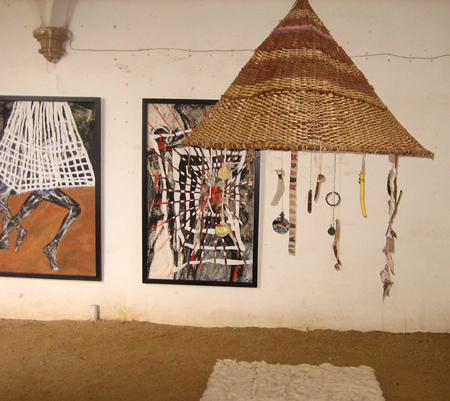
“Life is a journey. The river invites us to travel. The water we see now, in a while, will not be the same except if we join it…”
One of the pieces, Nomad House, conceived by Catherine Henke, one of the founders of the Oficinas do Convento, was a sculpture light enough for easy travel that could also be hung from a tree for immediate shelter. The woven roof, shaped like a large hat, had objects of necessity hanging down within reach. On the ground, there was a comfortable carpet of sheep’s wool. It turned out to be a bit heavy and cumbersome, more of a concept than a practical reality. Earlier paintings of warriors, reworked with the same technique of cutting and weaving used for the roof were displayed alongside. Henke, originally from Geneva, Switzerland, has been living in M-o-N for over 38 years.
Catherine, how did you end up in Portugal?
I came after the revolution when my partner was allowed to enter Portugal again. He had gone to study in Switzerland to not take part in the colonial war in Africa. We bought a little piece of land where we practice organic agriculture. When I arrived at M-o-N in 1976, it was completely different at that time. Much more rural, no foreigners. In 1978 and 1980 we traveled for 6 months, each time through Africa.

In 1981 I made my first exhibition, an installation in Lisbon at the gallery cooperative Diferença. The work was called el-le m’aime? to refocus myself after all these changes of places (Geneva – Africa – M-o-N), of culture, climate, language. El-le m’aime? is, above all, the theme of the double, of the mirror.
A transparent plastic curtain squirted with white and gold paint, in which my silhouette was cut, hung at the entrance of the exhibition. You had to pass through my body to enter.
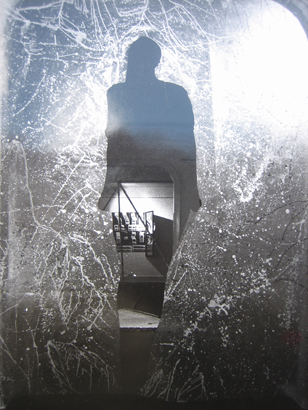
In the first room, the pyramid in the center was a place of contemplation, meditation, a place of ritual and magic. All around on the walls at floor level were representations on paper of pyramids, a red, a yellow, a blue.
In the second room, there was a window with mirrors that distorted the viewer’s appearance. I’d colored with pencils photocopies of these images and displayed them with photography and paintings of my body fragmented and painted. Before leaving Switzerland, I was working with photocopies. The mirror was to show a parallel, a bridge between then and now.
In reading the translation for the cartography project you did, Lines – Ways – Street, you have used titles like Macrocosm, Microcosm, Memories, Creativity, Skins, Tactility, Undesirable Odors & Pollution of the River, Ecology and Childhood. Can you talk more about these maps?
In autumn of 2012, I took part in Lilian Amaral’s workshop on mapping at the Oficinas do Convento. I outlined a series of maps of Montemor. Afterwards in my studio, I realized them on canvas in larger dimensions. I exchanged e-mails with Lilian and sent her pictures of these new maps.
In the Map of Creativity, the red strings indicate the creative relations between groups/associations and individuals/artists in M-o-N. There are 3 main spots: the Oficinas do Convento, Espaço do Tempo and the Câmara Municipal (city hall), along with other important associations involved in arts and education like the Telheiro, Alma d’ Arame (puppet space), Ruinas (theater), Oficina da Criança (children’s workshop), Centro Juvenil (youth center) and the Filmes da Praça (for the production of animations), and there are all the visual artists and musicians as well. So as you can see, it’s quite a web. Around M-o-N, the circle with little arrows illustrates outside directions for actual and future projects.
And the microcosm map?
I translated a text from the French philosopher Gilles Deleuze, “Escape is to trace a line, lines, a whole cartography. We only discover worlds through a long broken line (…) On the escaping lines, there may have only one thing: the experimentation of life.”
So, the escaping line represents Deleuze’s idea of deterritorialization-reterritorialization. “To escape” doesn’t mean going out of the world or renouncing it. Deleuze constructs his concept making a comparison between the root of a tree, which is like a pivot, and the roots of grass, which are rhizomatic like broken lines. In his view, when you think “tree,” you think a lot about the beginning and the end (alpha/omega), when you think “grass,” you are in the middle, you are just letting yourself go along an escaping line, on a line of desterritorialização. It’s like “to rave” (in french délirer). When you are searching, you don’t search in a direct line, but in broken lines, in many directions and changes of direction. This is the process where you will discover things, new worlds. In this way of thinking, drawing is also tracing escaping lines, broken lines on which, and with which, you are looking for something. You are searching in order to show your way of seeing.
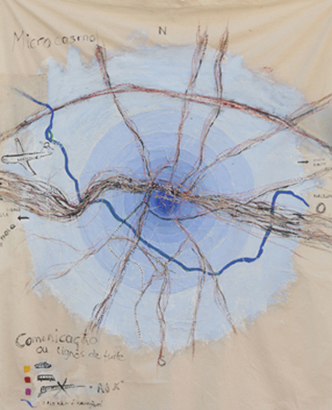
You also approached Deleuze’s concept of deterritorilization-reterritorialization in another mapping project, didn’t you?
Yes, Lilian Amaral had put me in contact for some poetic exchanges with a young Portuguese artist, Inês Moura, living in São Paulo, who had also done a mapping workshop with her. Other ideas that Inês and I also considered for this project were water/ inside-outside/near-far/ and sentido which in Portuguese means, way, direction, senses, feeling. In our six months of correspondence, we discussed both of us being foreigners in the countries where we are living. It was an exchange of words, the dialogue of two artists who were trying to understand through cartography, a sense of location, landscapes, and concerns about their adoptive countries. Instead of us each doing an individual installation, we created a 4 Hands work, a collaboration done by 2 people, therefore, 4 hands.
Our cartography of words was called correspondences. Last spring, this installation was presented in a collective exhibition in São Paulo. We still have never met.
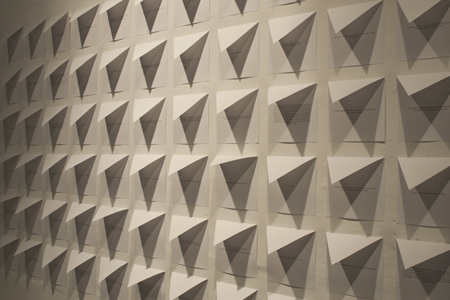
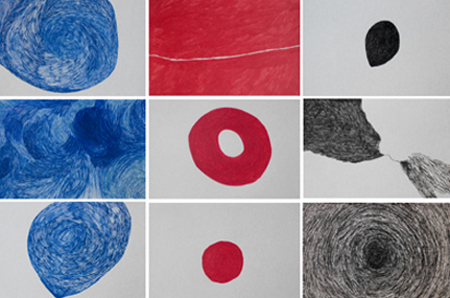
Have you continued with this idea of 4 Hands?
I’ve just started a 4 hands project, but with a different idea with my friend Claire Fressynet, a painter who lives in Lisbon. It will be like a patchwork of pictures. We will be making rolls of images, like a film with A6 images, about the place where each of us lives. Claire is working with the city, vertically. I’m working with the country, horizontally. At the end it will look like a huge weft or frame. On each roll, we are addressing a different theme that concerns city or country; like the floor, sky, reflex and shadows, spaces between, what remains.
You were one of the artists invited to realize a site specific installation among oak trees organized by dancer and choreographer Vera Manteiro in collaboration with the Centro de Investigação Cultura e Sustentabilidade (Center for Cultural Investigations and Sustainability), an organization focused on transitioning into a more ecologically, politically and socially balanced and just way of life?
Yes, it was a different initiative than a regular exhibition of art, where not only artists were invited. The idea was that it would be a three-hour presentation outside in a field. Even though most of the artists invited presented pieces of art, it was more about postures, attitudes and activities. Actually, it took much more time to prepare than to show it!
I took part in this project with my nine psycogéografic maps of M-o-N. I hung them down from the trees in a circle with two elements always present, the avenue and the river. On the floor I drew a large circular map with ashes, where I marked the avenue in black and the river in blue and a cross to indicate where the event happened.
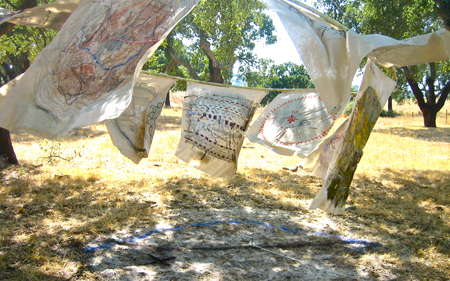
In watching the videos from the event, I could see that there was a crisscrossing of nature, philosophy, art, music, poetry and performance while people were walking through the fields observing and interacting.
Yes, it was about “an exploration of other possibilities for acting critically in the world and to thereby create worlds.” The event was called Oferecem-Se Sombras (We Offer Shadows) and held in a baldio (communal field) in Herdade da Adua.
It was also a nice experience to make this installation outside and to expose it directly to nature with bright summer light, to hear the noise of the wind and to feel my work animated by it. By not having walls, I could feel the earth and straw under my feet just like in my everyday life.
I’ve just come across the results of a study that RUcaS (Real Utopias in Socially Creative Spaces) did on arts-based local strategies “to address and discuss socially creative forms of rural renaissance (real utopias)” where they evaluated cultural and artistic initiatives from two points of view, the artists and the population. What was this questionnaire about that they gave to 400 residents in M-o-N?
First, there was a one-day workshop with “the creatives,” which were not only artists, but anyone who worked around creating. After that they realized a questionnaire for the residents. It was basically asking what the “creatives” gave to M-o-N and what M-o-N gave to the “creatives” along with many sub-questions like; Did you go to any artistic events in M-o-N? What kind of events? How did you know about them? Do you know any artists in M-o-N? Do you know any associations working with art? What is for you the most important legacy? What are the places of inspiration?
The most important events referred to included the annual feira (fair) in September, popular music and Oficinas do Canto, the School of Ballet, etc. where kids take part. Since there are many differences in literacy, educational background and awareness of contemporary art in the community, it seems evident that the arts can never reach all of the people, so answers really varied. I guess what the study expressed was how important education is through art and how we have to keep on in that direction.
Over the years you’ve been actively involved in designing art programs for children, like “The School and the River” and “Architecture and Inhabited Space.”
Yes,“The School and the River” was a multidisciplinary project which happened outside of the school and close to the river with the idea of putting some theoretical knowledge into practice. The second phase of the course happened around a garden we’d made and taken care of.
For 3 years now, Nuno Grenha and I have created and realized educational projects about earth construction for children and young people in collaboration with the O.C, the Juvenil Center, the Oficina da Criança and the Public Schools.
Our first project was called “Architecture and Inhabited Space,” and all the kids from the primary school of the region took part in it.We divided the project into 3 sections, “The Body,” “The House” and “The City.” First, we did a series of body exercises, since the information related to how the body perceived space; then each child built a little “dream” house with clay that was fired in the kiln and painted with chalk and pigment. We tried to understand the organization of a city through different questions. Where does our food, our water come from? Where does our garbage and used water go? Where are we going to educate our children? We then built the common buildings and constructed an imaginary city, which was exhibited at the annual fair.

Another project was “The Tile is a Seed” where we fabricated tiles in the Telheiro. We talked about what was missing in the school and tried to find ideas for our construction. We turned them into drawings. The construction was built with the fired tiles that we had made along with other ones and painted with chalk and pigments. The result was a concha de conversa – eco teatro (a shell for conversation – an eco theater).
Living all these years in Portugal has to have influenced your work.
It did. The fact that I came from the city to the countryside, from a grey town like Geneva, where during the winter you rarely see the sun, to Alentejo that has such a special light, has influenced my ideas and creative direction a lot. I feel a strong influence of Nature, of the organic space around me, of earth and cosmic rhythms. Nature is a huge master of creativity. Spending time in Nature gives me access to more creativity, to freedom and bliss. Also the territory around me has influenced me a lot in the choices of materials. I use a lot of natural material in my work, like earth, cork. I used to make paper with straw and all kinds of plants, etc.
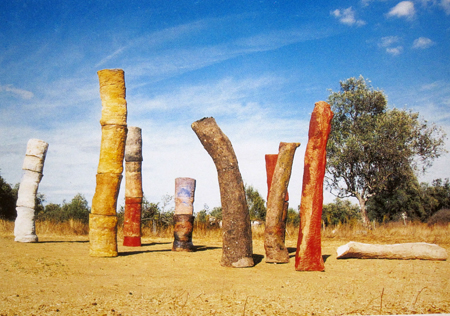
In 1998 I made a work called Espirito da terra that was born from walks I made in the montado close to my house. I found pieces of cork of different shapes and sizes. I liked these pieces and started to collect them. You can see in them the passage of time and action of the weather. Some months later, I was making experimentations with recycled paper mixed with pigments and natural dry material. At a certain moment, I remembered the pieces of cork and used them as molds. After a while, I started using bigger pieces and built oak trees. It was a process of giving memory to the shape. The paper comes from trees and is meeting again its mold in the tree’s skin.
Herborizar, a work I made for the project Rio organized by the Oficinas do Convento, was also influenced by the landscape. Artists and art students were invited to create work in a specific territory.
I chose four medicinal plants which grew near the river. They were spontaneous plants which have the faculty of being born and can develop by themselves without anybody treating them. They naturally repeat the cycle of their life for an indefinite time. I’ve been observing the place where they live, the conditions they need, their virtues and utilities. I contemplated their different phases and developed a group of paintings trying to make a parallelism between natural growth and artistic creation.

In an interview I recently read between Heidi Norton, who uses live plants in her artwork, and Michael Marder, a philosopher on the life of plants, Marder said that “In each of the places I have lived, plants have become the keepsakes of my memories, the mnemonic centers of gravity that evoke the events and even the atmosphere of my life at the time down to details.” How would you respond to this?
I looked at the work of Heidi Norton on Google and I’m really not interested in this process of keeping plants in a certain state. It just reminds me of the work of Damien Hirst with the animals, it’s a very similar process. It’s like stopping the flux of life like butterfly collectors. The plants and flowers should stay here. It’s not necessary to put them in a gallery or a museum. I’m much more interested in the thinking of Goethe. His book A Metamorphosis of Plants was great support to the work I did about plants. It’s nice to watch this everlasting transformation whose rhythm is modified by external conditions. The plant has a strong instinct of survival, as soon as the conditions are unfavorable, the process of going to seed begins. Goethe has very acute observations and I found a lot of similarities with the observations I’ve had. “Keepsakes of the memory.“ I’m not sure. The same plants in different contexts can be so different. For example, the same mushroom that you can eat in one place, but in another country with different soil and climate, it becomes toxic. I remember a wild plant I loved to eat in Switzerland in salads, and here it’s impossible, it’s so bitter. Marder says that he is a nomad, but the plants stay. In my view, the plants also travel. They just have a different scale. One thing that I love about plants is how they are showing us the process of cycles, eternal cycles.
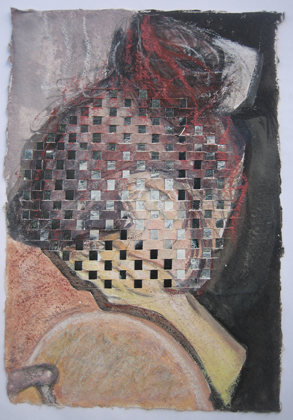
This theme of the eternal cycle can be seen in a work I did on Penelope’s weaving. She finished at the end of the day and undid her weaving during the night. Here we have the beat of the vital rhythm, inhaling and exhaling, of day and night, of life and death. The thread writes the space of separation and measures time. It’s also a metaphor of a woman’s daily life.
Life-death-life
Inspire-expire-inspire
Day-night-day
Everyday: do
Every night: undo
And again redoing
Organic agriculture? How has this integrated into your creative process?
It isn’t always easy because it means a lot of things to do and a lot of energy. But also with organic agriculture, I get closer to Nature, and as I said before, Nature is of great inspiration. Also it’s my way of getting more implanted, of creating roots.
Next week for the first time in my life, I’ll be doing a residency. I see it as a luxury. I will have all my time just to create. Somebody else will be doing the cooking and cleaning. I also know that it can’t be like this all the time and that all kinds of experiences that can provoke a process of creation are necessary.
Where is this residency? And what are you hoping to work on while you are there?
I’m going to Terena, a little village about 110kms from M-o-N, close to the Spanish border. For five days I will have a room and a space for working in the house of the young couple, Ana & Sergio, who organized the event. The project is called Projecto Lamparina, where they have invited about 30 artists for artistic residencies that will be happening over 7 sessions from February to June. There will be an online catalog and a final collective exhibition. Each artist will realize a piece of work related to anarcheological site in the region and to Endovélic, the most well-known of the antic gods of Lusitania.
My idea is to go and work in one of the oldest and more emblematic magic places of the region, the rock sanctuary for Endovélic, Santuário da Rocha da Mina. There are some stairs that have been made into the rock with a primitive altar at the top to present offerings to the god. Behind the altar there is a well. It seems that in this sanctuary, the practices of incubação happened. I would like to work on the stones to make “frottages”(a surrealist and automatic method of creative production developed by Max Ernst) on canvas and different kinds of paper to get their textures with earth, grass, flowers and graphite. This technique lets me stay with a memory base of the place as well as a conductor of dreams. Then, I’ll see what happens and how I’ll go on. I will have to take all my materials from here because I won’t be able to buy them there. Well, I’ve never been there, so I will tell more when I come back!
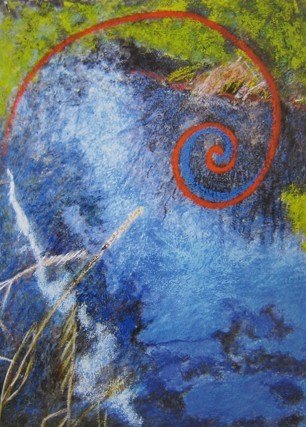
In the catalog for Spirits on the Water, Teresa Pinto Correia wrote about your work as a relationship between place as “an anchor in space, giving us the chance of embracing and living in it” and the surrounding landscape where traces stay that help us discover the spirt of a place: “if we lose all these traces, the landscapes will mislead us.”
She means that place is personal, each of us has preferred different places. I think that if we lose the traces, we lose the memory of the landscape. And, in losing this memory we lose a big part of its meaning, what our ancestors are counting on us for and what they have done and believed.
While I was in Terena, I met a sculptor, Aníbal Ferreira, who has been restoring a group of houses nearby with the same techniques people have been using for centuries on land he had bought about 8 years ago. The most important thing for him has been to keep the spirit of the place going through its memories, the cleaning of the stones (schist) and following the course of water, but doing it as a sculpture. An incredibly beautiful place and an incredible work.
In this otherwise very wild region also appear plantations of eucalyptus, but they don’t have anything to do with the landscape. They’re just there for business. They destroy the earth. After them, nothing grows anymore. They destroy the spirit of the place.
You must have had an amazing time at the residency. How did the making of the frottages work out?
Yes I had a good time. I took lots of walks to visit the archeological sites close to the river Lucefecit. There were so many flowers, lots of smells and so many stones. There are so many schists in this region that it seemed like somebody had seeded them! Doing “frottages” worked. I made a lot of experimentations in small dimensions with many different kinds of paper and then with canvas. The slate rock cut through many of the papers, not all were resistant. I rubbed them with graphite and flowers of different colors. Afterwards in the house, I worked on them with gouache and oil sticks, following the language of the stones. It’s a little like making prehistoric dreams. Now I’m working on a large canvas on both sides. I’m sewing lines and adding eyelets to create a relationship of passage between one side and the other, between one world and the other, between a world which is more related to materials and the other more to dreams and imagination. On one side a more concrete vision of the place is conserved and on the other side, the writing of dreams!
Supposedly, if you sleep in the sanctuary of the chthonic oracle and healer Endovelicus, he will visit your dreams offering advice about your future. Did you consider sleeping in the sanctuary?
I wouldn’t have slept in the sanctuary. There is something a bit lugubrious about it. Strange energies. But in the middle of the day when it was so hot, I stayed in a kind of a hole for some meditation. Later, when I was painting, it’s like I was dreaming. I don’t know if it was about future or past. I guess it was more about the past. Again, spirit and memories of the place.
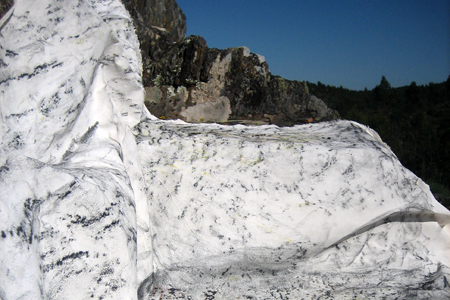

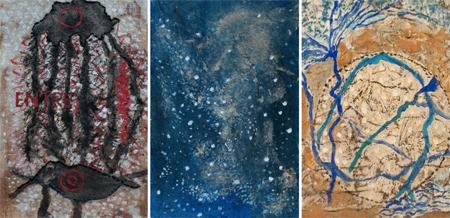
Querida Catherine, que linda e emocionante matéria sobre sua longa e intensa trajetória.
Fico especialmente feliz com a menção ao projeto Cartografias Inventadas que realizamos na Residência nas Oficinas do Convento.
Estamos finalizando somente agora o catálogo com a colaboração de Fernando Codevilla que faz seu doutoramento no Instituto de Artes e integra nosso grupo de Pesquisa. Em e-mail para você, enviarei a versão quase finalizada que passou por umaúltimarevisão e espera o ISBN.
Deixo umgrande abraçoefetuoso para você, Tiago, Nonos, Virgínia, enfim, os amigos de Montemor-o-Novo, sempre renovado!
Felicidades e até breve, neste ano vou a Espanha e Portugal, em Novembro.
Catherine , belo documento sobre o teu trabalho e percurso ,a entrevista é uma óptima forma .
Conhecia já algumas peças tuas e pinturas , mas agora tenho uma visão bem mais completa , parabéns pelo teu fazer e por levares outros a fazer .
Congratulations, a very impressive and profound interview, great work, keep going.
Catherine, Gostei muito da entrevista que me enviaste: trabalho muito interessante e fiquei a saber um pouco mais da tua vida. Em especial, gostei imenso do conteúdo desta frase por ti transcrita “We only discover worlds through a long broken line (…) On the escaping lines, there may have only one thing: the experimentation of life.” Obrigada Catherine.